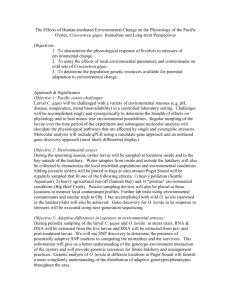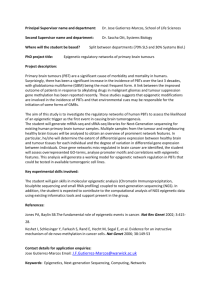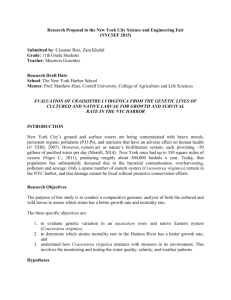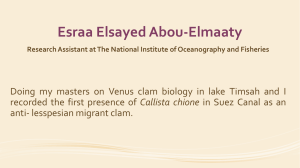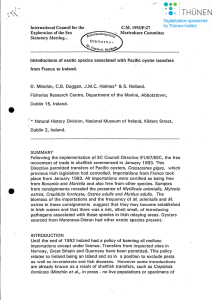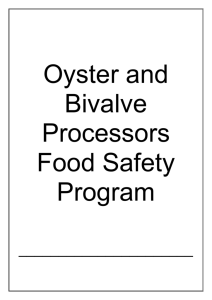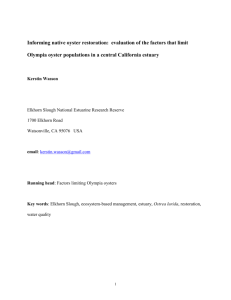Aquarium Proposal 379KB Sep 24 2010 01:57:45 PM
advertisement
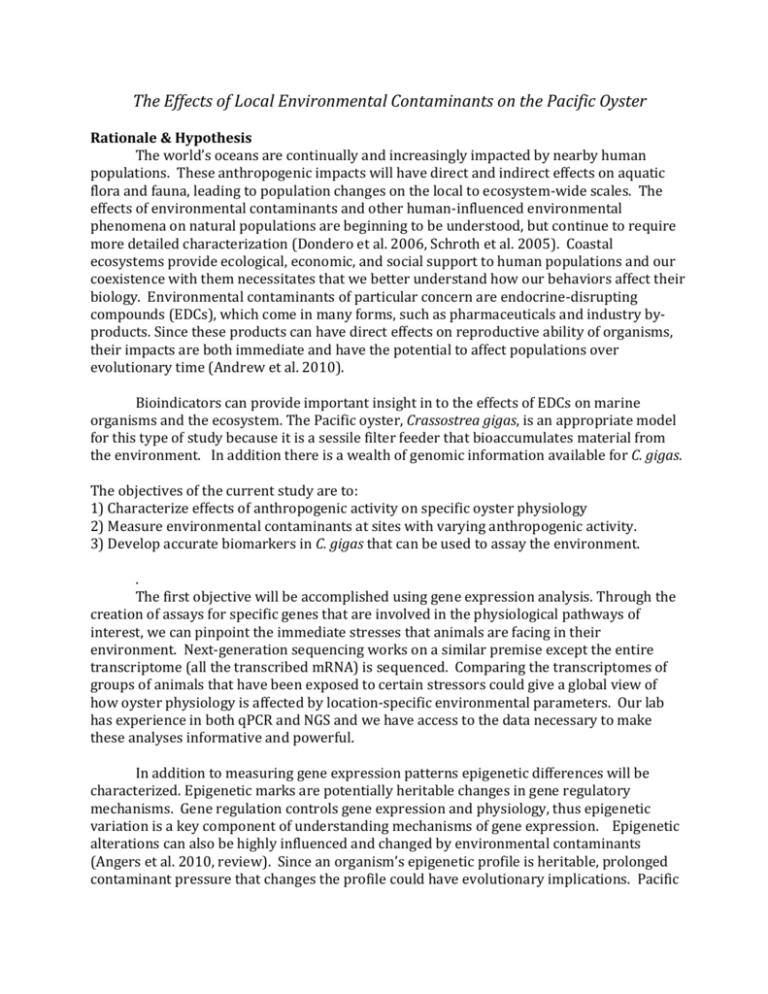
The Effects of Local Environmental Contaminants on the Pacific Oyster Rationale & Hypothesis The world’s oceans are continually and increasingly impacted by nearby human populations. These anthropogenic impacts will have direct and indirect effects on aquatic flora and fauna, leading to population changes on the local to ecosystem-wide scales. The effects of environmental contaminants and other human-influenced environmental phenomena on natural populations are beginning to be understood, but continue to require more detailed characterization (Dondero et al. 2006, Schroth et al. 2005). Coastal ecosystems provide ecological, economic, and social support to human populations and our coexistence with them necessitates that we better understand how our behaviors affect their biology. Environmental contaminants of particular concern are endocrine-disrupting compounds (EDCs), which come in many forms, such as pharmaceuticals and industry byproducts. Since these products can have direct effects on reproductive ability of organisms, their impacts are both immediate and have the potential to affect populations over evolutionary time (Andrew et al. 2010). Bioindicators can provide important insight in to the effects of EDCs on marine organisms and the ecosystem. The Pacific oyster, Crassostrea gigas, is an appropriate model for this type of study because it is a sessile filter feeder that bioaccumulates material from the environment. In addition there is a wealth of genomic information available for C. gigas. The objectives of the current study are to: 1) Characterize effects of anthropogenic activity on specific oyster physiology 2) Measure environmental contaminants at sites with varying anthropogenic activity. 3) Develop accurate biomarkers in C. gigas that can be used to assay the environment. . The first objective will be accomplished using gene expression analysis. Through the creation of assays for specific genes that are involved in the physiological pathways of interest, we can pinpoint the immediate stresses that animals are facing in their environment. Next-generation sequencing works on a similar premise except the entire transcriptome (all the transcribed mRNA) is sequenced. Comparing the transcriptomes of groups of animals that have been exposed to certain stressors could give a global view of how oyster physiology is affected by location-specific environmental parameters. Our lab has experience in both qPCR and NGS and we have access to the data necessary to make these analyses informative and powerful. In addition to measuring gene expression patterns epigenetic differences will be characterized. Epigenetic marks are potentially heritable changes in gene regulatory mechanisms. Gene regulation controls gene expression and physiology, thus epigenetic variation is a key component of understanding mechanisms of gene expression. Epigenetic alterations can also be highly influenced and changed by environmental contaminants (Angers et al. 2010, review). Since an organism’s epigenetic profile is heritable, prolonged contaminant pressure that changes the profile could have evolutionary implications. Pacific oysters have epigenetic control of genes, with evidence that this control is especially important in genes related to stress and environmental response (Gavery & Roberts 2010). The combined analysis of gene expression and epigenetic analysis will be complemented by the deployment of passive sampling devices (PSDs) that will monitor the contaminants that are in the immediate environment of the oysters. These pieces of biological and chemical data will provide detailed profiles of the three sites that are part of this study. Two of the sites are influenced by significant, but different, types of human impact. Samish Bay has frequent high levels of fecal coliform and is in close proximity to a number of agricultural activities. Downtown Seattle is near significant urban activity and a number of sewage outfalls. The control site, Big Beef Creek, is relatively secluded and removed from high population densities and agriculture. Inter-site comparisons of oyster physiological response (gene expression and epigenetics) and detailed analysis of aquatic contaminants will provide specific and complete information on how different types of anthropogenic activity are affecting aquatic populations and the Puget Sound ecosystem as a whole. Materials & Methods Pilot Study There will be a pilot study of the effectiveness of the PSDs in measuring contaminants in salt water before the study begins. Two PSDs will be deployed at the urban site (downtown Seattle) for a few weeks and then analyzed for known contaminants. The PSDs and oysters will be deployed on Aquarium property as discussed with Tim Carpenter (see diagram below). A weighted line will be suspended from the walkway below the harbor seal aquarium to the seafloor. The PSDs will be attached to the line at a height where they will constantly be submerged. Once oysters are introduced, they will be attached further up the line where they will be periodically exposed to the air during the tidal cycle. Environmental Monitoring Inbred lines of juvenile C. gigas will be provided by Taylor Shellfish (total of 310 oysters). Oysters will be put in bags in the mid to high intertidal zone at each site. There will be a total of 100 oysters outplanted at each site (50 per bag). The 10 other oysters will be sampled the day of outplanting. Oyster shell length, depth, and width will be measured. Oysters will then be shucked and gill tissue will be collected for gene expression analysis (stored in RNAlater) and epigenetic analysis (stored in 90% ethanol). This will be the sampling protocol at each sampling timepoint throughout the study. Oysters will be sampled every other month at low tide, at approximately the same tide each timepoint. At each timepoint, all oysters will be observed and dead individuals will be noted and removed. Ten oysters will be measured and sampled as previously described, all others will be returned to their bags and replaced in the intertidal. As discussed with Tim Carpenter, sampling times will be pre-arranged and Aquarium staff will be informed of the necessary time for sampling (tidal cycle-dependent). A researcher (and possibly one assistant) will require access to the walkway beneath the harbor seal aquarium to haul up and collect the oysters. Measurements and tissue samples will be taken on site. The entire process will take no more than 2 hours. At the end of sampling, the oysters and PSDs will be returned to the water in the same spot. Two PSDs will be deployed next to the oyster bags at the beginning of the study. Every other month when the oysters are sampled, the membranes of the PSDs will be removed and replaced with fresh ones. Laboratory Analysis All gene expression and epigenetic analysis will be accomplished at the University of Washington in Steven Roberts’s lab (School of Aquatic and Fishery Sciences). Aquatic contaminant analysis will be contracted to Pacific Northwest Laboratory (Battelle, Sequim, WA) where there is a lab with extensive experience in this kind of analysis. Final data analysis and synthesis will be done at UW. Timeline (See Attached)



